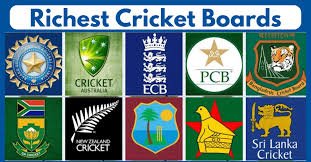The richest cricket boards in history are often ranked based on their financial reserves, annual revenues, and overall influence in the sport. Here’s a look at some of the richest cricket boards, particularly focusing on their historical and contemporary standing:
1. Board of Control for Cricket in India (BCCI)
The Board of Control for Cricket in India (BCCI) is the governing body for cricket in India and the wealthiest cricket board globally. Established in 1928, it operates as an independent body responsible for organizing, promoting, and managing cricket in India across all levels. The BCCI’s influence extends far beyond Indian borders, making it a significant force in international cricket.Below are some key details about the BCCI:
- Net Worth: $2.25 billion
- Revenue Sources: Broadcasting rights (e.g., IPL and international matches), sponsorships, and advertisements.
- Key Achievements:
- The Indian Premier League (IPL) is a massive contributor to its wealth.
- BCCI dominates global cricket politics due to its financial power.
- Historical Note: BCCI’s wealth skyrocketed after the launch of the IPL in 2008, making it the undisputed richest cricket board.
2. England and Wales Cricket Board (ECB)
- Net Worth: 492 Crores
- Revenue Sources: Domestic cricket (e.g., The Hundred, County Cricket), international matches, and broadcasting rights.
- Key Achievements:
- The ECB has historically been well-funded due to England’s long cricketing history and stable fan base.
- The introduction of The Hundred added new revenue streams.
3. Cricket Australia (CA)
Cricket Australia (CA) is the national governing body for cricket in Australia, responsible for managing and promoting the game at all levels, from grassroots to international cricket. It is one of the most influential cricket boards globally due to Australia’s rich cricketing history and consistent international success. Below are key details about Cricket Australia:
- Net Worth: $79 million
- Revenue Sources: Big Bash League (BBL), international matches, and broadcasting.
- Key Achievements:
- CA has been financially robust thanks to a strong cricketing tradition and leagues like the BBL.
- Australia’s consistent success on the field helps attract sponsors and fans.
Challenges
- Player Workload Management:
- Balancing busy international schedules with domestic commitments.
- Competition from Other Sports:
- Australian Rules Football (AFL), rugby, and soccer compete for attention and funding.
- Big Bash League Challenges:
- Declining viewership in recent years due to extended schedules and player availability issues.
- Declining viewership in recent years due to extended schedules and player availability issues.
- Player Workload Management:
4. Pakistan Cricket Board (PCB)
The Pakistan Cricket Board (PCB) is the governing body for cricket in Pakistan, responsible for managing all levels of the sport, from grassroots to international cricket. Established in 1949, the PCB has played a crucial role in developing and promoting cricket in Pakistan, a country with a passionate fan base and a rich cricketing history. Below are the key details about the PCB:
- Net Worth: $55 million
- Revenue Sources: International broadcasting deals, Pakistan Super League (PSL), and sponsorships.
- Key Achievements:
- The PSL has bolstered PCB’s financial status in recent years.
- PCB faces challenges due to limited international cricket on home soil for over a decade, which impacted revenues.
-
Vision for the Future
The PCB is focused on:
- Increasing the popularity of cricket among youth.
- Enhancing the PSL’s global reputation.
- Hosting more international cricket matches in Pakistan.
- Strengthening the women’s cricket program.
The PCB plays a vital role in shaping cricket in Pakistan and is an integral part of the international cricket community.
5. Cricket South Africa (CSA)
Cricket South Africa (CSA) is the governing body for cricket in South Africa, responsible for overseeing all levels of the game, from grassroots development to the national teams. Established in 1991, CSA succeeded the United Cricket Board of South Africa (UCBSA) following South Africa’s re-admission to international cricket after the apartheid era. CSA has since been a major player in global cricket.
- Net Worth: $47 million
- Revenue Sources: Mzansi Super League, international matches, and sponsorships.
- Key Achievements:
- South Africa’s strong cricketing history and competitiveness contribute to its financial standing.
- South Africa’s strong cricketing history and competitiveness contribute to its financial standing.
6. New Zealand Cricket (NZC)
New Zealand Cricket (NZC) is the governing body for cricket in New Zealand, overseeing the development, promotion, and management of the sport across the country. Known for its resourcefulness and competitive spirit, NZC has successfully fostered a strong cricketing culture despite being a relatively small cricketing nation. Below are the key details about NZC:
- Net Worth: $9 million
- Revenue Sources: International matches and broadcasting rights.
- Key Achievements:
- Despite limited resources, NZC manages to remain competitive on the global stage.
Future Vision
- Strengthening grassroots cricket and increasing youth participation.
- Enhancing the women’s cricket program and achieving parity with the men’s game.
- Hosting more international events to grow cricket’s popularity in New Zealand.
- Retaining top talent and ensuring financial sustainability.
New Zealand Cricket’s success is a testament to its innovative approach, strong team culture, and effective management, making it a respected member of the international cricket community.
- Despite limited resources, NZC manages to remain competitive on the global stage.
Historical Context
- The financial dominance of cricket boards like the BCCI reflects not just cricket’s popularity in their countries but also their ability to commercialize the sport.
- Boards like ECB and CA have had a long history of wealth due to their role in popularizing and institutionalizing the game.
- The rise of T20 leagues (IPL, PSL, BBL) has significantly influenced the financial rankings of boards in the last two decades.
